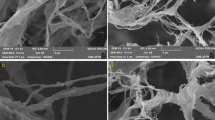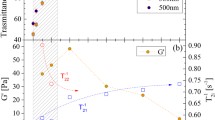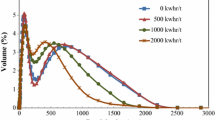Abstract
The role of surface modification on rheological properties of fibrillated cellulose suspensions has been evaluated under creep, oscillatory, and rotational testing conditions. Two types of fibrillated cellulose were produced by mechanical homogenization, followed by the deposition of poly(styrene-co-maleimide) or SMI nanoparticles containing encapsulated palm oil on the fibril surfaces. During static creep testing, the modified fibrils changed into fully viscous properties, while native fibrils showed viscoelastic behavior at low stresses. A lower viscosity and reduction in hysteresis effects were experienced during steady-state rotational flow testing, together with a reduction in yield stress after modification. A study of viscoelastic properties by oscillatory testing illustrated that the cross-over point between storage and loss moduli was shifted towards lower strains by surface modification as an indication for the enhancement of liquid-like properties observed for SMI/oil nanoparticle dispersions, while the transition point was hardly affected by fibrillation. The variations in rheological properties were overruled by surface modification and reduction in hydrogen bonding interactions of modified fibrillated cellulose, whereas rheological properties of a physical mixture of native fibrillated cellulose suspension and nanoparticle dispersion remained dominated by the fibrillated cellulose.










Similar content being viewed by others
Explore related subjects
Discover the latest articles and news from researchers in related subjects, suggested using machine learning.References
Herrick FW, Casebier RL, Hamilton JK, Sandberg KR (1983) Microfibrillar cellulose: morphology and accessibility. J Appl Polym Sci Polym Symp 37:797–813
Pääkkö M, Ankerfors M, Kosonen H, Nykänen A, Ahola S, Österberg M, Ruokolainen J, Laine J, Larsson PT, Ikkala O, Lindström T (2007) Enzymatic hydrolysis combined with mechanical shearing and high-pressure homogenization for nanoscale cellulose fibrils and strong gels. Biomacromolecules 8:1934–1941
Hassan ML, Hassan EA, Oksman KN (2011) Effect of pretreatment of bagasse fibers on the properties of chitosan/microfibrillated cellulose nanocomposites. J Mater Sci 46:1732–1740. doi:10.1007/s10853-010-4992-4
Rezayati-Charani P, Dehghani-Firouzabadi M, Afra E, Blademo Å, Naderi A, Lindström T (2013) Production of microfibrillated cellulose from unbleached kraft pulp of Kenaf and Scotch Pine and its effect on the properties of hardwood kraft: microfibrillated cellulose paper. Cellulose 20:2559–2567
Bendahou A, Kaddami H, Dufresne A (2010) Investigation on the effect of cellulosic nanoparticles’ morphology on the properties of natural rubber based nanocomposites. Eur Polym J 46:609–620
Nguyen HD, Mai TT, Nguyen NB, Dang TD, Le ML, Dang TT, Tran VM (2013) A novel method for preparing microfibrillated cellulose from bamboo fibers. Adv Nat Sci Nanosci Nanotechnol 4:015016–015025
Bhattacharya D, Germinario LT, Winter WT (2008) Isolation, preparation and characterization of cellulose microfibers obtained from bagasse. Carbohydr Polym 73:371–377
Kaushik A, Singh M, Verma G (2010) Green nanocomposites based on thermoplastic starch and steam exploded cellulose nanofibrils from wheat straw. Carbohydr Polym 63:337–345
Phiriyawirut M, Chotirat N, Phromsiri S, Lohapaisarn I (2010) Preparation and properties of natural rubber-cellulose microfibril nanocomposite films. Adv Mater Res 93–94:328–331
Lavoine N, Desloges I, Dufresne A, Bras J (2012) Microfibrillated cellulose—its barrier properties and applications in cellulosic materials: a review. Carbohydr Polym 90:735–764
Siqueira G, Tadokoro SK, Mathew AP, Oksman K (2010) Carrot nanofibers and nanocomposites applications. In: 7th international symposium on natural polymers and composites, Gramado, Brazil
Habibi Y, Vignon MR (2007) Optimization of cellouronic acid synthesis by TEMPO-mediated oxidation of cellulose III from sugar beet pulp. Cellulose 15:177–185
Alila S, Besbas I, Vilar MR, Mutjé P, Boufi S (2013) Non-woody plants as raw materials for production of microfibrillated cellulose (MFC): a comparative study. Ind Crops Prod 41:250–259
Siro I, Plackett D (2010) Microfibrillated cellulose and new nanocomposite materials: a review. Cellulose 17:459–494
Salo T, Dimic-Misic K, Gane P, Paltakari J (2015) Application of pigmented coating colours containing MFC/NFC: coating properties and link to rheology. Nord Pulp Paper Res J 30:165–178
Nechita P, Panaitescu DM (2013) Improving the dispersibility of cellulose microfibrillated structures in a polymer matrix by controlling drying conditions and chemical surface modifications. Cell Chem Technol 47:711–719
Agoda-Tandjawa G, Durand S, Berot S, Blassel C, Gaillard C, Garnier C (2010) Rheological characterization of microfibrillated cellulose suspensions after freezing. Carbohydr Polym 80:677–686
Peng Y, Gardner DJ, Han Y (2011) Drying cellulose nanofibrils: in search of a suitable method. Cellulose 19:91–102
Missoum K, Bras J, Belgacem MN (2012) Organization of aliphatic chains grafted on nanofibrillated cellulose and influence on final properties. Cellulose 19:1957–1973
Stenstad P, Andresen M, Tanem BS, Stenius P (2008) Chemical surface modifications of microfibrillated cellulose. Cellulose 15:35–45
Huang P, Zha Y, Kuga S, Wu M, Huang Y (2016) A versatile method for producing functionalized cellulose nanofibers and their application. Nanoscale 8:3753–3759
Littunen K, Hippi U, Johansson LS, Österberg M, Tammelin T, Laine J, Seppälä J (2011) Free radical graft copolymerization of nanofibrillated cellulose with acrylic monomers. Carbohydr Polym 84:1039–1047
Björkman U (2003) Break-up of suspended fibre networks. Nord Pulp Paper Res J 18:32–37
Lowys MP, Desbrieres J, Rinaudo M (2001) Rheological characterization of cellulosic microfibril suspensions: role of polymeric additives. Food Hydrocoll 15:25–32
Saarikoski E, Saarinen T, Salmela J, Seppälä J (2012) Flocculated flow of microfibrillated cellulose water suspensions: an imaging approach for characterisation of rheological behaviour. Cellulose 19:647–659
Goussé C, Chanzy H, Cerrada ML, Fleury E (2004) Surface silylation of cellulose microfibrils: preparation and rheological properties. Polymer 45:1569–1575
Karppinen A, Vesterinen AH, Saarinen T, Inen PP, Seppälä J (2011) Effect of cationic polymethacrylates on the rheology and flocculation of microfibrillated cellulose. Cellulose 18:1381–1390
Naderi A, Lindström T (2014) Carboxymethylated nanofibrillated cellulose: effect of monovalent electrolytes on the rheological properties. Cellulose 21:3507–3514
Naderi A, Lindström T, Sundström J (2014) Carboxymethylated nanofibrillated cellulose: rheological studies. Cellulose 21:1561–1571
Missoum K, Belgacem MN, Bras J (2013) Nanofibrillated cellulose surface modification: a review. Materials 6:1745–1766
Sorvari A, Saarinen T, Haavisto S, Salmela J, Vuoriluoto M, Seppälä J (2014) Modifying the flocculation of microfibrillated cellulose suspensions by soluble polysaccharides under conditions unfavorable to adsorption. Carbohydr Polym 106:283–292
Korhonen MHJ, Sorvari A, Saarinen T, Seppälä J, Laine J (2014) Deflocculation of cellulosic suspensions with anionic high molecular weight polyelectrolytes. Bioresources 9:3550–3570
Fujisawa S, Okita Y, Fukuzumi H, Saito T, Isodai A (2011) Preparation and characterization of TEMPO-oxidized cellulose nanofibril films with free carboxyl groups. Carbohydr Polym 84:579–583
Veen SJ, Versluis P, Kuij A, Velikov KP (2015) Microstructure and rheology of microfibril-polymer networks. Soft Matter 11:8907–8912
Ahola S, Myllytie P, Österberg M, Teerinen T, Laine J (2008) Effect of polymer adsorption on cellulose nanofibril water binding capacity and aggregation. Bioresources 3:1315–1328
Rastogi VK, Stanssens D, Samyn P (2016) Reaction efficiency and retention of poly(styrene-co-maleimide) nanoparticles deposited on fibrillated cellulose surfaces. Carbohydr Polym 141:244–262
Samyn P, Van Nieuwkerke D, Schoukens G, Vonck L, Stanssens D, Van den Abbeele H (2012) Quality and statistical quantification of Brazilian vegetable oils using FTIR and Raman spectroscopy. Appl Spectrosc 66:552–565
Taheri H, Samyn P (2016) Effect of homogenization (microfluidization) process parameters in mechanical production of micro- and nanofibrillated cellulose on its rheological and morphological properties. Cellulose 23:1221–1238
Samyn P, Van Nieuwkerke D, Schoukens G, Stanssens D, Vonck L, Van den Abbeele H (2015) Hybrid palm-oil/styrene maleimide nanoparticles synthesized in aqueous dispersion under different conditions. J Microencaps 32:336–348
Saarinen T, Haavisto S, Sorvari A, Salmela J, Seppälä J (2014) The effect of wall depletion on the rheology of microfibrillated cellulose water suspensions by optical coherence tomography. Cellulose 21:1261–1275
Nechyporchuk O, Belgacem MN, Pignon F (2014) Rheological properties of micro-/nanofibrillated cellulose suspensions: wall-slip and shear banding phenomena. Carbohydr Polym 112:432–439
Samyn P, Schoukens G, Stanssens D, Vonck L, Van den Abbeele H (2015) Kaolinite nanocomposite platelets synthesized by intercalation and imidization of poly(styrene-co-maleic anhydride). Materials 8:4363–4388
Ratna T, Philipp S, Paul Q (2010) Effect of nanoparticle concentration on zeta-potential measurement results and reproducibility. Particuology 8:279–285
Liang CY, Marchessault RH (1959) Infrared spectra of crystalline polysaccharides. I. Hydrogen bonds in native celluloses. J Polym Sci 37:385–395
Fan M, Dai D, Huang B (2012) Fourier transform infrared spectroscopy for natural fibres. In: Salih MS (ed) Fourier transform—materials analysis. InTech, Crotia
Garside P, Wyeth P (2003) Identification of cellulosic fibres by FTIR spectroscopy—thread and single fibre analysis by attenuated total reflectance. Stud Conserv 4:269–274
Lee CM, Kubicki JD, Fan B, Zhong L, Jarvis MC, Kim SH (2015) Hydrogen-bonding network and OH stretch vibration of cellulose: comparison of computational modeling with polarized IR and SFG spectra. J Phys Chem B 119:15138–15149
Liang CY, Marchessault RH (1959) Infrared spectra of crystalline polysaccharides. II. Native celluloses in the region from 640 to 1700 cm−1. J Polym Sci 39:269–278
Maréchal Y, Chanzy H (2000) The hydrogen bond network in Iβ cellulose as observed by infrared spectrometry. J Mol Struct 523:183–186
Yuan L, Wan J, Ma Y, Wang Y, Huang M, Chen Y (2013) The content of different hydrogen bond models and crystal structure of eucalyptus fibers during beating. Bioresources 8:717–734
Kondo T (1997) Effect of cationic polymethacrylates on the rheology and flocculation of microfibrillated cellulose. Cellulose 4:281–292
Guo Y, Wu P (2008) Investigation of the hydrogen-bond structure of cellulose diacetate by two-dimensional infrared correlation spectroscopy. Carbohydr Polym 74:509–513
Struszcyk H (1986) Modification of lignins. III. Reaction of lignosulfonates with chlorophosphazenes. J Macromol Sci A 23:973–992
Pimentel GC, Sederholm CH (1956) Correlation of infrared stretching frequencies and hydrogen bond distances in crystals. J Chem Phys 24:639
Nelson ML, O’Connor RT (1964) Relation of certain infrared bands to cellulose crystallinity and crystal lattice type. Part I. Spectra of types I, II, III and of amorphous cellulose. J Appl Polym Sci 8:1311–1324
Åkerholm M, Hinterstoisser B, Salmén L (2004) Characterization of the crystalline structure of cellulose using static and dynamic FT-IR spectroscopy. Carbohydr Res 339:569–578
Oh SY, Yoo DI, Shin Y, Kim HC, Kim HY, Chung YS, Park WH, Youk JH (2005) Crystalline structure analysis of cellulose treated with sodium hydroxide and carbon dioxide by means of X-ray diffraction and FTIR spectroscopy. Carbohydr Res 340:2376–2391
Janardhnan S, Sain M (2011) Targeted disruption of hydroxyl chemistry and crystallinity in natural fibers for the isolation of cellulose nanofibers via enzymatic treatment. Bioresources 6:1242–1250
Liu Y, Thibodeaux D, Gamble G (2011) Development of Fourier-transform infrared spectroscopy in direct, non-destructive, and rapid determination of cotton fiber maturity. Textile Res J 81:1559–1567
Cintron MS, Hinchliffe DJ (2015) FT-IR examination of the development of secondary cell wall in cotton fibers. Fibers 3:30–40
Taheri H, Stanssens D, Samyn P (2016) Rheological behaviour of oil-filled polymer nanoparticles in aqueous dispersion. Colloids Surf A 499:31–45
Barnes HA (2000) A handbook of elementary rheology. Institute of Non-Newtonian Fluid Mechanics, University of Wales Press (Wales), Aberystwyth
Dinand E, Chanzy H, Vignon M (1996) Parenchymal cell cellulose from sugar beet pulp: preparation and properties. Cellulose 3:183–188
Iotti M, Gregersen Ø, Moe S, Lenes M (2011) Rheological studies of microfibrillar cellulose water dispersions. J Polym Environ 19:137–145
Bröckel U, Meier W, Wagner G (2013) Product design and engineering: formulation of gels and pastes. Wiley, Heidelberg
Herschel WH, Bulkley R (1926) Konsistenzmessungen von gummi-benzollosungen. Kolloid-Z 39:291–300
Acknowledgements
This study was funded by Robert Bosch Foundation in the framework of the Juniorprofessorenprogram “Sustainable use of Natural Materials” (‘Foresnab’-Project 2011–2016) and the Juniorprofessorenprogramm Baden-Württemberg (‘NaCoPa’-Project 2012–2015). We thank Dirk Stanssens at Topchim N.V. (Wommelgem, Belgium) for assistance with surface modification reactions. We thank Dr. Ralph Thomann at Freiburger Materialforschungszentrum (FMF) for TEM analysis.
Author information
Authors and Affiliations
Corresponding author
Ethics declarations
Conflict of interests
The authors declare that they have no conflict of interest.
Electronic supplementary material
Below is the link to the electronic supplementary material.
Rights and permissions
About this article
Cite this article
Samyn, P., Taheri, H. Rheology of fibrillated cellulose suspensions after surface modification by organic nanoparticle deposits. J Mater Sci 51, 9830–9848 (2016). https://doi.org/10.1007/s10853-016-0216-x
Received:
Accepted:
Published:
Issue Date:
DOI: https://doi.org/10.1007/s10853-016-0216-x




